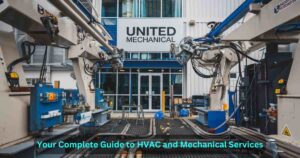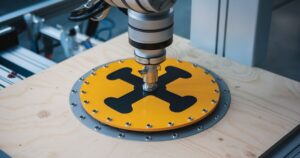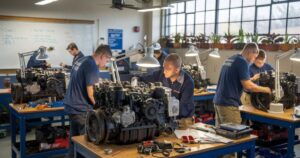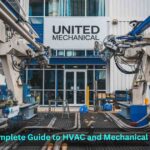Welding is an exciting skill that opens the door to countless creative and practical projects. If you’re just starting out, knowing which tools you need can help you feel confident and prepared.
In this guide, we’ll cover 20 basic welding tools and equipment every beginner should have. From protective gear to welding machines, each tool serves a purpose in ensuring you work safely and effectively.
Let’s explore the essential welding tools that will set you on the path to success!
What are Welding Tools?
Welding tools are essential equipment used in the welding process. They help join two or more pieces of metal together. These tools come in various forms, each serving a specific purpose.
The most common welding tool is the welding machine. This device generates the heat needed to melt the metal. There are different types of welding machines, such as MIG, TIG, and Stick welders. Each type is suited for different projects and materials.
Another important tool is the welding torch. This handheld device directs the heat to the metal surfaces. It can be used with gas or electric welders. Proper control of the torch is vital for a strong weld.
Safety equipment is also crucial in welding. Welders should wear protective gear, including gloves, helmets, and goggles. These items protect against sparks, heat, and harmful radiation.
Welders use clamps and jigs to hold materials in place. This ensures precise alignment while welding. Good organization of tools and materials is important for efficiency and safety.
Welding tools are the backbone of the welding process. They enable welders to create strong, durable joints between metal pieces. Understanding these tools is key to successful welding projects.
Why Welding Accessories are Necessary?
Welding accessories are crucial for enhancing the welding process. They improve efficiency, safety, and the quality of the final product. Without these accessories, welding can be more challenging and less effective.
First, accessories like clamps and fixtures help hold metal pieces securely in place. This prevents movement during welding, which can lead to misalignment. Proper alignment is essential for strong and accurate welds.
Second, protective gear, such as helmets, gloves, and aprons, is vital for safety. Welding produces intense heat and bright sparks. These can cause severe injuries without the right protection. Accessories ensure that welders can work safely and confidently.
Third, tools like welding rods and filler materials are necessary for specific tasks. They fill gaps and provide additional strength to welds. Using the correct materials improves the durability of the joints.
Cleaning tools and brushes help prepare surfaces before welding. Clean surfaces allow for better adhesion, leading to stronger welds. Regular maintenance of welding accessories also extends their lifespan and performance.
Finally, welding accessories enhance comfort and convenience. Items like adjustable stands and tool holders reduce fatigue during long projects. This leads to more focused and efficient work.
Welding accessories are essential for a successful welding operation. They contribute to safety, precision, and the overall quality of the work. Investing in the right accessories can make a significant difference in welding results.
Welding Tools Name List
Welding accessories and tools are essential items that support the welding process, enhancing safety, efficiency, and quality. They include a variety of equipment used alongside welding machines to help with tasks such as cutting, joining, and finishing metal components.
Here’s a list of welding accessories and tools:
- Welding Machine (Welder)
- Welding Helmet
- Welding Gloves
- Welding Jacket or Apron
- Welding Goggles
- Welding Respirator
- Welding Electrodes (Welding Rods)
- Welding Wire
- Welding Clamps
- Welding Magnet
- Chipping Hammer
- Wire Brush
- Welding Pliers
- Welding Tongs
- Ground Clamp (Earth Clamp)
- Welding Table
- Welding Cart
- Welding Curtain
- Welding Blanket
- Tungsten Electrodes (for TIG welding)
- MIG Gun (for MIG welding)
- Welding Nozzles and Tips (for Oxy-Acetylene welding)
- Welding Regulators (for gas welding)
- Cylinder Cart (for gas cylinders)
- Welding Positioner
- Welding Vise
- Welding Stinger
- Welding Flux
- Welding Tungsten Sharpener
- Welding Fume Extractor
Top 20 Essential Welding Tools And Equipment For Beginners
1. Welding Hammers
Welding hammers are specialized tools used in the welding process for various tasks. They are designed to help manipulate and shape metal, remove slag, and ensure the integrity of welds. Here’s a closer look at different types of welding hammers and their purposes:
Chipping Hammer
This tool is primarily used to remove slag from welds after the welding process. Slag is the byproduct of welding that can interfere with the strength and appearance of the weld. A chipping hammer typically has a flat, pointed end for effective slag removal.
Welding Hammer (Ball Peen Hammer)
A ball peen hammer features a flat striking surface on one end and a rounded end on the other. It’s often used for shaping metal, striking chisels, and creating indentations. The ball peen end is particularly useful for peening welds to improve their strength.
Slag Hammer
Similar to a chipping hammer, a slag hammer is designed specifically to remove slag from the weld. It may have a larger head and a longer handle, providing more leverage for tougher slag removal.
Welders’ Mallet
This tool is used for delicate tasks where a softer strike is required. It is typically made of rubber or plastic, preventing damage to the metal surface while providing enough force to shape or adjust components.
Sledge Hammer
A heavier tool used for more extensive metal shaping or for driving larger components together. It’s less common in fine welding work but can be necessary for heavy-duty projects.
Importance of Welding Hammers
Welding hammers are essential for achieving clean, strong, and aesthetically pleasing welds. Using the appropriate hammer for the task ensures that welds are free from defects and that the metal is manipulated correctly without causing damage. Proper maintenance of these hammers is also crucial; keeping them clean and free of rust ensures longevity and effectiveness in the welding process.
2. MIG Pliers
MIG pliers are specialized tools designed specifically for use in Metal Inert Gas (MIG) welding. They serve multiple functions that enhance the efficiency and quality of the welding process. Here’s a closer look at their features and uses:
Features of MIG Pliers
MIG pliers have several important features that make them useful for welding. First, they combine cutting and gripping functions in one tool. This saves time and effort for welders. The cutting edge is sharp and designed to snip welding wire quickly.
The pliers also have a long, narrow nose, which helps reach tight spaces. They are made from durable materials, so they can handle tough jobs. Many MIG pliers have rubberized handles for a comfortable and secure grip, making them easy to use for long periods.
Uses of MIG Pliers
MIG pliers are used for various tasks in welding. One main use is cutting wire. The sharp edge allows welders to trim the welding wire to the right length. This helps ensure clean and accurate welds. The gripping side of the pliers holds metal pieces in place while tacking them together.
This keeps everything aligned before welding. MIG pliers also help manage the welding wire, making it easier to feed and control during the process. Some pliers can even remove slag from welds, resulting in a cleaner finish. Overall, MIG pliers are essential tools that improve efficiency and quality in welding.
3. Adjustable Wrenches
Adjustable wrenches are versatile hand tools commonly used in various tasks, especially in welding and mechanical work. They are designed to grip and turn nuts, bolts, and other fasteners of different sizes.
The most notable feature of an adjustable wrench is its movable jaw, which allows the user to adjust the opening to fit various sizes of fasteners. This eliminates the need for multiple wrenches, making it a practical choice for any toolbox.
Features of Adjustable Wrenches
One of the key features of adjustable wrenches is the smooth adjustment mechanism. This allows for quick changes to the jaw size, providing a tight grip on fasteners. Many models come with a built-in scale, which helps users determine the size of the opening.
The handle is often designed for comfort and leverage, making it easier to apply force when turning stubborn nuts or bolts. Additionally, adjustable wrenches are usually made from strong materials like steel, ensuring durability and longevity.
Uses of Adjustable Wrenches
Adjustable wrenches have a wide range of uses. They are commonly used to tighten or loosen nuts and bolts in various applications, from plumbing to automotive work. In welding, they can adjust fittings or secure equipment in place.
Their versatility makes them suitable for both professional mechanics and DIY enthusiasts. With an adjustable wrench, users can quickly switch between different sizes of fasteners without needing multiple tools. This feature saves time and effort, making the adjustable wrench a must-have in any toolkit.
4. Welding Clamp
Welding clamps are essential tools that play a crucial role in the welding process. They are designed to hold metal pieces securely in place, ensuring that they remain aligned during welding. Proper clamping is vital for achieving strong and accurate welds.
Types of Welding Clamps
There are various types of welding clamps, each suited for specific applications. Common types include:
C-Clamps: Versatile clamps that can hold flat surfaces together and provide a strong grip.
Locking Clamps: These clamps can hold materials without continuous pressure, making them convenient to use.
Corner Clamps: Ideal for creating right angles, especially useful for framing tasks.
Materials and Construction
Welding clamps are typically made from durable materials such as steel or aluminum. These materials can withstand the heat and stress of welding operations. Many clamps feature rubber pads or coatings to protect the metal surfaces being joined and to provide a better grip.
Importance of Clamping in Welding
Clamping is vital in the welding process as it helps maintain the alignment of metal pieces. Without proper clamping, workpieces can shift, leading to weak joints and poor-quality welds. Secure clamping also prevents warping, ensuring consistent welds that meet project specifications.
Safety Benefits of Welding Clamps
Welding clamps contribute to safety by minimizing the risk of movement during the welding process. Properly clamped workpieces reduce the chances of accidents and injuries, allowing welders to work more confidently. They help create a stable working environment, making the welding process safer overall.
Versatility in Various Applications
While primarily used in welding, these clamps are versatile enough for various fabrication tasks. They can be used in woodworking and metalworking projects, making them valuable tools for both professionals and DIY enthusiasts. Their adaptability enhances their utility in different workshops.
Investing in Quality Clamps
Investing in high-quality welding clamps can significantly improve the quality and efficiency of welding tasks. Reliable clamps enhance precision and safety, making them indispensable tools in any welding operation. Whether for professional use or home projects, having the right clamps can make a noticeable difference.
5. Angle Grinder
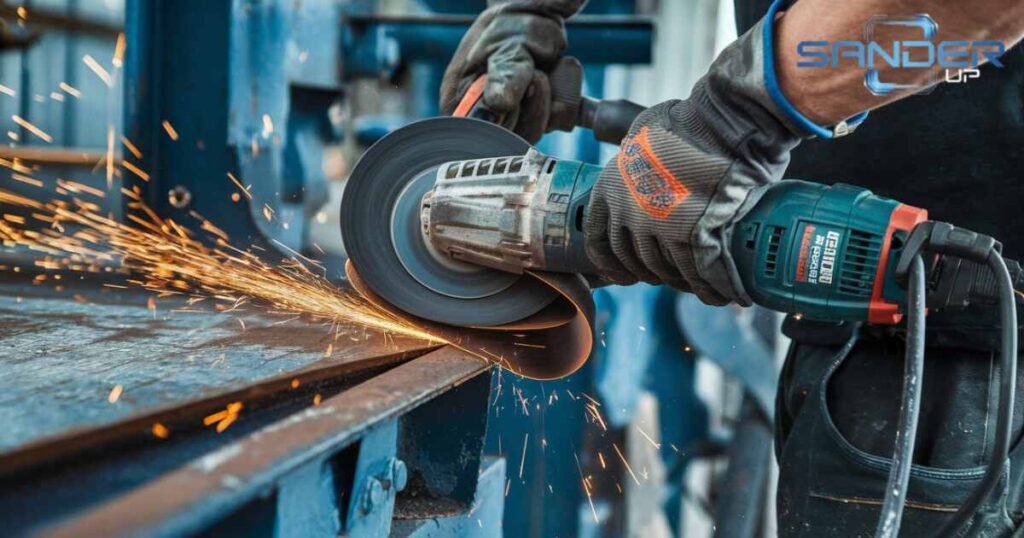
An angle grinder is a powerful tool used in welding, metalworking, and construction. It features a rotating disc that spins at high speeds, allowing it to cut, grind, and polish various materials like metal, stone, and concrete. The discs are interchangeable, with specific types for cutting, grinding, or polishing. An adjustable guard and side handle provide safety and better control during use.
One of its key functions is cutting through materials such as metal pipes or concrete. By attaching a cutting disc, it can make precise cuts quickly and cleanly. Additionally, angle grinders are great for grinding down welds, smoothing rough edges, and preparing surfaces for further work.
Angle grinders are also useful for polishing metal, removing rust, or stripping away old paint. With the right attachment, they can give surfaces a clean, polished finish. This versatility makes them essential in various trades.
Safety is important when using an angle grinder. Protective gear, such as gloves and goggles, is necessary to shield against sparks and debris. Proper disc selection and tool handling are also crucial to ensure safe operation.
In summary, an angle grinder is a versatile, must-have tool in any workshop. It handles a wide range of tasks, from cutting to finishing, making it an essential tool for professionals and hobbyists alike.
6. Auto-Darkening Welding Helmet
An auto-darkening welding helmet is a protective headgear designed specifically for welders. Its primary function is to shield the welder’s face and eyes from the harmful effects of intense light, heat, and sparks generated during the welding process. Unlike traditional welding helmets, which require the user to flip the lens up and down manually, auto-darkening helmets have a special lens that automatically adjusts to varying light intensities.
The lens of an auto-darkening helmet darkens instantly when the welder strikes an arc, protecting the eyes from the bright light and ultraviolet (UV) radiation. When the arc is not active, the lens remains in a lighter shade, allowing the welder to see clearly without having to remove the helmet. This automatic feature provides convenience and efficiency, as welders can focus on their work without constantly adjusting their helmets.
Auto-darkening welding helmets are also adjustable in terms of sensitivity and delay settings. This allows welders to fine-tune how quickly the lens darkens and how long it stays dark after the welding is done. These settings help adapt the helmet to different types of welding, such as MIG, TIG, or arc welding.
Safety is a key advantage of auto-darkening helmets. They not only protect the eyes from harmful light but also prevent neck strain caused by repeatedly flipping the helmet. Additionally, modern helmets are lightweight, comfortable, and equipped with padding, making them suitable for long hours of work.
In summary, an auto-darkening welding helmet is an essential tool for welders. It combines convenience, safety, and comfort, allowing for better focus and efficiency during welding tasks. Its advanced technology ensures the welder’s eyes are protected while improving overall workflow.
7. Welding Gloves
Welding gloves are vital protective gear for welders, designed to shield hands from extreme heat, sparks, and electrical hazards. Made from durable, heat-resistant materials like leather, these gloves allow welders to handle hot materials safely while offering flexibility.
Different types of gloves are suited for specific welding processes. MIG welding gloves are thicker for heat protection, while TIG gloves are thinner for better dexterity. Stick welding gloves offer the highest level of protection due to the intense heat involved.
In addition to heat protection, welding gloves guard against electrical shock and provide a strong grip for handling tools. They are essential for safety and comfort in any welding task.
8. Welding Magnets
Welding magnets are handy tools used to hold metal pieces in place during the welding process. They come in various shapes and sizes, with strong magnetic properties that help stabilize workpieces at specific angles. This feature is particularly useful when welding items like frames, brackets, or pipes.
These magnets are designed to make the welding process more efficient and accurate. By securely holding pieces together, welding magnets free up the welder’s hands, allowing them to focus on the welding task itself. This not only speeds up the process but also improves the quality of the welds by ensuring that the pieces remain aligned.
Welding magnets typically have built-in angles, commonly at 45, 90, and 135 degrees, which help welders position materials precisely. Their sturdy construction allows them to handle heavy metal components without losing their grip. Additionally, many welding magnets have a durable coating that protects them from heat and spatter.
Welding magnets are essential tools for any welder. They provide stability and support during the welding process, making it easier to achieve accurate and high quality results. By reducing the need for clamps or manual holding, welding magnets enhance efficiency and safety in the workspace.
9. Welding Framing Jig
Welding framing jigs are essential tools that provide stability and precision during the welding process. They hold metal pieces securely in place, ensuring correct alignment and angles while welding. This not only speeds up fabrication but also helps create strong, consistent joints.
Available in various designs, welding jigs can be adjustable or fixed, depending on the project’s needs. They are typically made from durable materials that withstand high temperatures and heavy loads.
Using a framing jig enhances safety by reducing movement during welding, which minimizes the risk of misalignment and injuries. Overall, welding framing jigs are vital for achieving accurate, high quality welds and improving efficiency in the workspace.
10. Speed Square
Speed squares are essential tools in carpentry, construction, and welding for measuring and marking right angles. Made from durable materials like aluminum or plastic, their triangular shape allows for quick and accurate measurements.
Primarily, speed squares help mark straight lines and angles, ensuring precise cuts for clean, accurate joints. Many models feature measurements along the edges for easy calculations.
They can also guide cutting tools, providing a straight edge for saws. Speed squares enhance efficiency and accuracy in various projects, making them indispensable for both professionals and DIY enthusiasts.
11. Metal Brush
Metal brushes are important tools used in welding, metalworking, and fabrication for cleaning and finishing metal surfaces. They typically have bristles made from steel, brass, or nylon, which effectively remove rust, paint, and other debris.
One of the primary uses of a metal brush is to prepare surfaces for welding or painting. By cleaning the metal, these brushes ensure better adhesion and stronger welds. They come in various shapes and sizes, including handheld brushes and drill attachments, allowing for versatility in different applications.
Metal brushes are also useful for smoothing rough edges and surfaces after welding. They help eliminate slag and improve the overall appearance of the finished product. Using a metal brush can enhance the longevity of metal items by removing corrosive materials.
Metal brushes are essential for achieving clean, well-prepared surfaces in welding and metalworking tasks. Their effectiveness in cleaning and finishing makes them valuable tools for professionals and hobbyists alike.
12. Sheet Metal Gauge
Sheet metal gauges are tools used to measure the thickness of sheet metal and other materials. They play a crucial role in metalworking, construction, and fabrication by ensuring precise measurements and consistency in projects.
Typically, sheet metal gauges come in a flat or spiral form with graduated markings that indicate different thickness levels. The gauge allows users to quickly assess the thickness of metal sheets, which is essential for selecting the appropriate materials and ensuring proper fit in assemblies.
Using a sheet metal gauge helps prevent errors in cutting, bending, and welding operations. It ensures that materials meet specific standards and requirements, leading to better quality and safety in final products. Understanding gauge numbers helps fabricators select the right materials for their specific applications.
Sheet metal gauges are vital tools for achieving accuracy and consistency in metalworking tasks. Their ease of use and precision make them essential for professionals and DIY enthusiasts in various industries.
13. Soapstone
Soapstone is a versatile tool used in welding and metalworking for marking and layout work. It is made from a soft, talc-based mineral that allows it to produce clear and precise marks on metal surfaces. Soapstone is favored for its ability to withstand high temperatures, making it suitable for welding applications.
One of the primary benefits of using soapstone is its visibility. The marks are easy to see, even on dark or shiny surfaces, ensuring accurate cuts and welds. Additionally, soapstone marks can be easily removed or ground off without damaging the underlying material.
Soapstone comes in various forms, including sticks or pencils, making it convenient for different applications. It is especially useful for marking cutting lines, alignment points, and other important details during the fabrication process.
In summary, soapstone is an essential marking tool in welding and metalworking. Its durability, visibility, and ease of use make it a favorite among professionals and DIY enthusiasts for achieving precision in their projects.
14. Metal File
Metal files are essential tools used in metalworking and fabrication for shaping and finishing metal surfaces. They consist of a hardened steel blade with a series of ridges or teeth that remove material when rubbed against the metal. Files come in various shapes, sizes, and coarseness levels, making them versatile for different tasks.
The primary purpose of a metal file is to smooth rough edges, remove sharp burrs, and refine surfaces after cutting or welding. This helps achieve a clean, professional finish and ensures safety by eliminating sharp edges. Files can be used on various metals, including steel, aluminum, and brass.
Metal files are typically categorized by their shape—flat, half-round, round, and triangular—each designed for specific applications. For example, flat files are ideal for large flat surfaces, while round files are used for internal curves and holes.
Metal files are vital tools for achieving smooth and accurate finishes in metalworking. Their effectiveness in shaping and refining metal makes them indispensable for both professionals and hobbyists.
15. Welding Boots
Welding boots are specialized footwear designed to provide protection and safety for welders in hazardous work environments. Made from durable materials, these boots often feature steel toes to protect against heavy falling objects and punctures.
One of the key benefits of welding boots is their heat resistance. Many models are designed to withstand high temperatures, protecting the feet from sparks, molten metal, and hot surfaces commonly encountered during welding tasks. The soles are typically made of heat-resistant rubber, providing additional safety.
In addition to heat protection, welding boots offer slip-resistant soles, ensuring stability and traction on various surfaces. This feature is essential for preventing slips and falls in potentially dangerous environments. Many welding boots also include comfortable insoles and breathable materials for long-lasting wear during extended work hours.
Welding boots are an essential part of a welder’s protective gear. They provide safety from heat, falling objects, and slips, making them crucial for maintaining a safe and efficient working environment.
16. Welding Cart
Welding carts are essential tools designed to organize and transport welding equipment efficiently. They provide a convenient solution for storing welding machines, tools, and accessories, keeping everything in one place for easy access during welding tasks.
Typically made from durable materials like steel or heavy-duty plastic, welding carts are built to withstand the rigors of a workshop environment. They often feature multiple shelves or compartments to accommodate various equipment, including welders, gas tanks, and hand tools. Many carts also come with wheels, making it easy to move equipment around the workspace.
Using a welding cart enhances safety by keeping tools organized and reducing the risk of tripping hazards. It also improves workflow by ensuring that everything needed for a job is readily available and easily accessible.
Some welding carts are designed with additional features, such as built-in work surfaces or holders for cables and hoses, further increasing their functionality. They provide organization, mobility, and safety, making the welding process more efficient and manageable.
17. Chipping Hammer
Chipping hammers are essential tools used in welding and metalworking for removing slag, spatter, and other impurities from welded joints. They typically feature a sturdy, flat head with a sharp edge designed for chipping away unwanted material. The handle is often made of wood or fiberglass for comfort and grip.
The primary function of a chipping hammer is to clean welds and prepare surfaces for additional welding or finishing. By removing slag and debris, these hammers help ensure better adhesion and stronger welds. They are especially useful after arc welding, where slag can accumulate on the surface.
Chipping hammers are lightweight and easy to maneuver, making them ideal for working in tight spaces. Some models may also include a pointed end for prying or scraping, adding to their versatility.
They enhance the quality of welds by ensuring clean surfaces and removing contaminants, making them indispensable for welders in various applications.
18. Safety Glasses
Safety glasses are crucial protective eyewear designed to safeguard the eyes from hazards encountered in welding, metalworking, and other industrial environments. They feature durable lenses that protect against flying debris, sparks, and harmful radiation, ensuring the welder’s vision remains safe during tasks.
These glasses typically have shatterproof lenses made from materials like polycarbonate, providing high impact resistance. Many safety glasses also come with anti-fog coatings to prevent fogging during intense activities, ensuring clear visibility.
In addition to protecting against physical hazards, safety glasses can filter harmful UV rays and bright light generated during welding. Some models are designed with side shields for added protection, covering peripheral vision.
Safety glasses are an essential component of personal protective equipment (PPE) for welders. They help prevent eye injuries and enhance visibility, making them vital for maintaining safety in the workplace.
19. MIG Welding Nozzle Gel
MIG welding nozzle gel is a specialized product designed to enhance the performance of MIG welding processes. This gel is applied to the welding nozzle to prevent spatter buildup, which can interfere with the quality of the weld and the efficiency of the welding operation.
The primary benefit of using nozzle gel is that it creates a protective barrier between the nozzle and the molten metal. This helps keep the nozzle clean, reducing the frequency of maintenance and cleaning required during welding. A clean nozzle ensures a consistent and smooth gas flow, which is essential for producing high-quality welds.
Nozzle gel also helps to improve arc stability by minimizing the risk of obstruction caused by spatter. This leads to better control during welding and reduces the chances of defects in the weld bead. Additionally, using nozzle gel can prolong the life of the welding nozzle, as it minimizes wear and tear caused by spatter buildup.
MIG welding nozzle gel is an effective tool for improving the efficiency and quality of MIG welding processes. By preventing spatter buildup and enhancing arc stability, it contributes to cleaner welds and less downtime for maintenance.
20. Cutting Torches
Cutting torches are essential tools used in metalworking and fabrication for cutting various materials, primarily metals. They operate by using a combination of high-temperature flames and oxygen to melt and remove metal, allowing for precise cuts.
The primary function of a cutting torch is to provide an intense flame that can easily cut through thick metal sheets or pipes. The torch typically consists of a handle, a gas supply system, and interchangeable tips that determine the size and shape of the flame. Common gases used include acetylene, propane, and natural gas.
Cutting torches are widely used in industries like construction, automotive, and manufacturing for tasks such as cutting, welding, and shaping metal components. Their versatility makes them suitable for various materials, including steel, aluminum, and cast iron.
Safety is crucial when using cutting torches, as the flames can be extremely hot and pose fire hazards. Proper protective gear, such as gloves and goggles, is essential to ensure the user’s safety during operation.
In summary, cutting torches are vital tools for metal cutting and shaping. Their ability to produce precise cuts and work with various materials makes them indispensable in many industrial applications.
homemade tools welding
Making your own tools for welding can be a cost-effective way to enhance your workshop. Here are some common homemade welding tools you can create:
- Welding Table
- Welding Cart
- Custom Clamps
- Welded Fixture
- Angle Grinder Holder
- Metal Rod Holder
- Slag Removal Tool
- Custom Welding Helmet
- Tack Welding Block
- Workpiece Support Stands
FAQ’s
What is the best welder for a beginner?
The best welder for a beginner is often a MIG welder. It’s user-friendly, requires less skill to operate, and is versatile for various projects. Look for models with adjustable settings and a spool gun for aluminum welding. Brands like Hobart and Lincoln Electric offer great options for beginners.
What are welding devices?
Welding devices are tools used to join materials, typically metals, by applying heat, pressure, or both. Common types include:
- MIG Welders: Use a wire feed and gas for welding.
- TIG Welders: Use a tungsten electrode and a filler rod.
- Stick Welders: Use a coated electrode for welding.
- Plasma Cutters: Cut metal using a high-temperature plasma.
What are the best welding tools?
The best welding tools include a reliable welding machine, such as a MIG, TIG, or stick welder. Quality protective gear, including a welding helmet, gloves, and jacket, is essential for safety. You will need the appropriate welding rods or wire for your chosen welding type.
Clamps are important for securing workpieces. An angle grinder is useful for cleaning and finishing welds. A welding table provides a stable workspace, while measuring tools like a ruler and square help ensure accuracy. Lastly, metal cutters are necessary for preparing materials.
What are 3 tools a welder needs?
Three essential tools a welder needs are:
- Welding Machine: For the actual welding process (MIG, TIG, or stick).
- Welding Helmet: For eye and face protection from sparks and UV rays.
- Welding Gloves: To protect hands from heat and sparks.
What do you need to weld at home?
To weld at home, you need a welding machine, such as MIG, TIG, or stick. Protective gear, including a helmet, gloves, and an apron, is essential for safety. A sturdy work surface or welding table is necessary for stability. You will also need metal pieces to weld, along with the appropriate welding rod or wire for your machine. Clamps are useful for holding the pieces together, and good ventilation is important to avoid fumes.
What are the tools and equipment used in welding?
The tools and equipment used in welding include:
- Welding machine (MIG, TIG, or stick)
- Electrodes or welding wire
- Protective gear (helmet, gloves, jacket)
- Welding clamps
- Welding table or workbench
- Angle grinder (for surface preparation)
- Chipping hammer (to remove slag)
- Wire brush (for cleaning)
- Measuring tools (ruler, caliper)
- Fume extractor or ventilation system (for safety)


